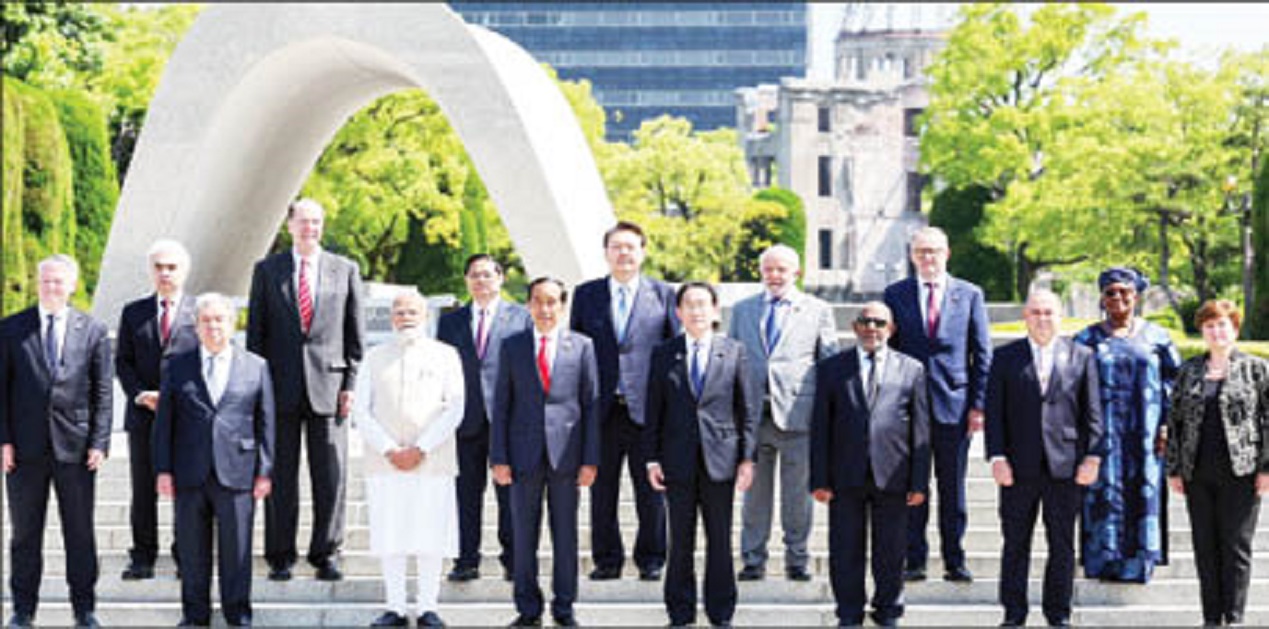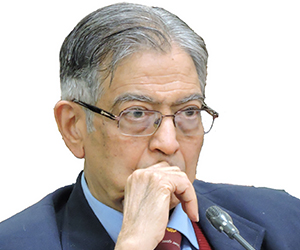Timidity has given way to self-confidence, lassitude to vigour, and confusion to clarity that India’s actions, governed by its civilizational values, will be taken independently and not under anyone’s pressure.
As a result of the Narendra Modi government’s transformative foreign policy India today is no longer a supplicant in the world comity of nations and enjoys a place on the high table. While in the past it was difficult to even secure appointments for our leaders with their counterparts from powerful countries, India is now courted and feted by most countries. Accordingly, Indians the world over, who were usually looked down upon, can hold their heads high.
India’s greatly enhanced stature may be attributed to the Prime Minister’s unflagging energy and to his vision that India guided by its ethos and civilizational values is destined for leadership in the international community. Due to his high energy levels the Prime Minister, who never takes a vacation, has been able to devote more personal attention than any of his predecessors to the onerous task of nation building inclusive of its foreign policy. It is no wonder, therefore, that while India has emerged as the fastest growing major economy on the verge of becoming an economic powerhouse, it has simultaneously established extensive mutually beneficial relationships with a wide range of countries cutting across regions, ideologies, cultures, and blocs. This process has been facilitated by its smartly leveraging its foreign policy to further its development goals and using its economic clout to promote its foreign policy endeavours.
RADICALLY DIFFERENT
The characteristics of the Modi government’s foreign policy are radically different from those of earlier governments. Timidity has given way to self-confidence, lassitude to vigour, and confusion to clarity that India’s actions, governed by its civilizational values, will be taken independently and not under anyone’s pressure, much less dictates. Accordingly, India has shed the long standing reticence about its Indianness and taken to not only expressing pride in its values but also in propagating them. Whether it be the call for observance of the International Day of Yoga, or the need to promote alternative medicine, or observing the philosophy of Vasudhaiva Kutumbakam coupled with the belief in the spiritual oneness of humankind together with an abiding commitment to the ideologies of dialogue, non-violence, and ecological conservation, India in recent times has boldly left the impress of the wisdom of its traditional thinking on the entire world as never before. Indian exhortations have fallen on receptive ears because of the innate value of what it propagates, because the complex problems facing the world have no other ready solutions, and because India is recognized as a force for good with no extra territorial ambitions and as a net security provider ready to help wherever possible. This was apparent during the Covid pandemic when India, apart from attending to its own needs, provided medicines and vaccines to over a hundred countries at a time when the more advanced countries with their blinkered mindsets did little to help. India has, moreover, been the first responder to regional humanitarian crises the world over and has robust development assistance programmes covering many countries particularly those in its immediate neighbourhood.
The Modi government’s uninhibited embrace of its Indianness has inevitably been accompanied by a conscious and powerful connect with the 25 million strong Indian diaspora which had become alienated due to the deliberate Nehruvian disassociation from it arising from concerns that linkages with the mother country might impair the sovereignty of the host countries. Such timidity has happily been jettisoned as evidenced by Prime Minister Modi’s assertion while addressing the Indian community in Malaysia in 2015 that India is not confined to the territory of India and exists in every Indian in every part of the world. Accordingly, in his travels abroad Modi makes it a point to address mammoth gatherings of the Indian diaspora, lauding their achievements, seeking to strengthen their linkages with the mainland and galvanizing them for their empowerment. Above all, any major issues faced by them to the extent resolvable by India like evacuation from troubled areas like Yemen, Iraq, Syria, Ukraine, Sudan etc., are promptly attended to. It is, therefore, but natural that the Indian diaspora today associates itself with India’s rise, is committed to promote the mother country and feels a sense of pride in its Indianness.
REMARKABLY DEFT
Indian foreign policy in the last nine years has been remarkably deft as it has coped near flawlessly with rapidly changing and indeed tumultuous scenarios arising out of the once in a century pandemic, the Ukraine conflict, China’s rise and unabashed expansionist agenda, heightened polarization between NATO and its gaggle of supporters on the one hand and the Sino-Russian entente on the other, and the rise of many middle powers like the UAE, Saudi Arabia, Turkey, Indonesia, Australia etc.
Recognising the critical importance of regional stability, the Modi government has wisely bestowed special attention to India’s South Asian neighbours. India’s relations with them have, inter alia, been bedeviled by the small country big country syndrome, a sense of neglect, inattention to longstanding issues and differences, and China’s machinations. In this backdrop, Prime Minister Modi in an unprecedented move invited the leaders of India’s immediate neighbours for his inauguration in 2014. This was followed up with his personally visiting these countries and frequent high level exchanges, generous assistance and where necessary massive bailout packages coupled with innumerable connectivity and development projects. In the process, the Modi government did not shy away from taking tough decisions and in displaying remarkable generosity. For instance, it unhesitatingly accepted the ruling of the Permanent Court of Arbitration in 2014 on the India Bangladesh maritime boundary which awarded around 80% of the disputed area to the latter. Similarly, in 2015 it grasped the nettle and addressed the thorny issue entailing the settlement of the land boundary with Bangladesh even though it involved much give and take of territory which inevitably aroused some opposition within India. As a result of this approach, India today enjoys excellent ties with Bhutan, Bangladesh and the Maldives and very good ties with Nepal and Sri Lanka even though the latter have not hesitated to play the China card every now and then.
THE AF-PAK QUESTION
Ties with Afghanistan have, however, been problematic ever since the terrorist tainted Taliban regime was allowed to take over power in that country in 2021 by the international community despite India’s reservations. Nevertheless, keeping in mind its age old linkages with the people of Afghanistan and putting aside its concerns about the Taliban regime, India has been providing considerable humanitarian assistance to the country by way of food and medical supplies. It has also pragmatically maintained some engagement with the Taliban regime in order to protect its equities in the country.
If relations with Afghanistan are problematic those with Pakistan are at an all time low with diplomatic representation at the level of charge d’affaires. Modi cannot, however, be faulted for this state of affairs as he tried all that he could to place the relationship on an even keel inviting Nawaz Sharif for his inauguration, making a surprise visit to Pakistan in December 2015 and promoting back channel talks. There is a certain inevitability in the downturn in the relationship given Pakistan’s anti Indian DNA as reflected in its persistence in the export of terrorism to India. In these circumstances, it is to the Modi government’s credit that it has smelt the coffee and unlike previous government’s made it clear that there can be no business as usual as long as Pakistan does not give up on the use of terror against India. It also needs to be commended for not having hesitated in responding militarily to major terrorist actions across the LoC as in the surgical strikes and across the IB in the Balakot action. Had previous Indian governments resorted to such punitive actions it is possible that Pakistan may have had second thoughts about engaging in terrorist attacks against India at will.
THE CHINESE PROBLEM
More worrisome than the troubled ties with Afghanistan and Pakistan is the state of relations with China. The last few years have witnessed concerted Chinese attempts at encroachments at several places along the LAC accompanied by considerable troop movement in violation of bilateral agreements. India has, however, stood firm and pushed back even though this has led to clashes. The Modi government has made it clear that there can be no normalization of relations without peace and tranquility along our borders which is dependent on the disengagement of troops and a restoration of the status quo ante. China’s aggressive posture has been accompanied by many anti Indian moves including inter alia its backing of Pakistan on the Kashmir issue and stymying efforts at imposition of UN sanctions on terrorists being sheltered by Pakistan. As in Pakistan’s case, China’s inimical moves against India come despite Modi’s best efforts at repairing ties inter alia through several one on one meetings with Xi Jinping. China’s anti India posture is unlikely to change any time soon as it views India as an obstacle to its hegemonic ambitions in the region. In these circumstances, the Modi government has done well not only by boldly resisting China’s salami slicing endeavours, by beefing up India’s defences, by building linkages with others similarly threatened, and by promoting the establishment of resilient supply chains, accompanied by its Aatmanirbhar programme, so as to de risk its economy from dependence on China. Such a multi-pronged effort demands the deployment of a gargantuan whole of government approach which is now underway to address the China challenge.
INDIA-U.S. & INDIA-RUSSIA
In the context of the rocky Sino India ties our relations with the United States assume great importance. Here Modi has done spectacularly well in successfully building upon the progress made in the past through the Presidencies of Obama, Trump, and Biden to make our relationship with the US the most wide ranging and most important. The fact that Modi is proceeding on a state visit to the US in June 2023, which will be only the third state visit hosted under the current Biden administration, bears testimony to this. The US is today India’s biggest trading partner and despite relentless media propaganda in that country against India there is bipartisan consensus in the US Congress in favour of India.
It is to the credit of the Modi government that improved India US ties have not come at the cost of India Russia ties. Indeed, India has also successfully resisted much pressure to take sides against Russia in the Ukraine conflict by condemning it, adhering to Western sanctions against it, and not purchasing discounted oil from it. The management of India’s neutral posture on the conflict has been nothing short of masterly and reflects a self-confident and persuasive foreign policy geared to the national interest.
BRIDGING THE GULF
The Modi government has also engineered a remarkable uptick in ties with the Gulf States which desirous of becoming modern states and guided by their long term interests see India as an invaluable partner. The process has been facilitated by Modi having visited most of these states more than once and having established a close personal rapport with their leaders. This has paid rich political dividends as these countries and India are now on the same page on issues like Islamic terror as borne out by the fact that whereas in the past terrorists from India could hope for safe havens in the region today they are handed over to India. Foreign direct investment from the region to India is on an upward curve. For instance, from 2017 to 2021 it was in excess of $6 billion from the UAE and $3 billion from Saudi Arabia. The icing on the cake is that these improved ties do not come at the cost of our relations with Iran and Israel. Indeed, in 2021 a grouping of Israel, India, US, and UAE ( I2U2) was established with a focus on joint investments and new initiatives in water, energy, transportation, space, health and food security. Under the aegis of the I2U2 there will be many projects like a hybrid 300 megawatts renewable energy project in Gujarat or like integrated food farms across India for which an investment of $2billion has been specifically committed by the UAE.
CLIMATE CHANGE
On climate change, the Modi government’s proactive and multi dimensional strategy has been able to deflect the pressure faced by India as a major gas emitter. While unyielding on the imperative that the developed countries must assist the developing world with finance and technology to reduce emissions it has announced that by 2070 it will be a carbon neutral economy. India in 2022 also upped its intended nationally determined contributions from the 2015 levels by indicating that by 2030 half of its installed electric power capacity would be from renewable energy and that the GDP emission intensity would be reduced by 45% as compared to that in 2005. Furthermore, India took the lead in launching the International Solar Alliance along with France. Above all, Prime Minister Modi in keeping with India’s civilizational values propagated a mass movement designed to promote a healthy and sustainable way of living based on conservation and moderation as a key to combating climate change. This has found a measure of resonance across the globe.
THE MARITIME DIMENSION
The maritime dimensions of Indian foreign policy have only come of age under the Modi government. New concepts to expand regional security and development cooperation among India’s maritime neighbours such as Security and Growth for All in the Region (SAGAR), the Indo Pacific concept and Quad are the more important of these.
SAGAR primarily embraces the Indian Ocean, and the Indian Ocean Rim Association forum has been boosted, as well as an Indian Ocean Dialogue. A trilateral maritime security dialogue between India, Sri Lanka and Maldives at the NSA level has been initiated with concerns about external threats including terrorism and Islamic radicalism in view.
India’s involvement and support for the Indo-Pacific concept extending from the US west coast to the east coast of Africa and the Quad comprising USA, Japan, Australia and India has steadily grown as a reaction to the China threat. Growing India-US defence ties, signing of logistics agreements with the US, Japan and Australia, the expansion of the Malabar exercise to include Japan and Australia, and the new dynamism in India-Australia ties, are also reflective of this. The Quad’s broader agenda, covering critical and emerging technologies, resilient and reliable supply chains, cybersecurity, connectivity, energy etc. serves India’s economic interests, beyond the purely security dimension.
IN CONCLUSION
To conclude, therefore, the Modi government’s bold and imaginative foreign policy has not only fully safeguarded India’s national interest in very difficult times but also greatly enhanced its international standing. The only issue on which it can be legitimately criticized is in regard to media management. With a little effort and imagination it could have negated or at least minimized the negative press that India has been getting particularly in the West.
Satish Chandra is a retired diplomat and former Deputy National Security Adviser.











Post new comment